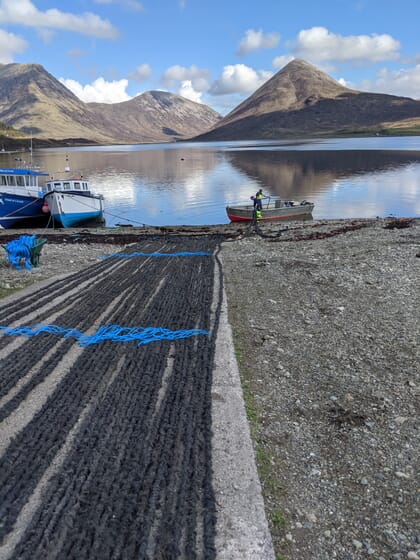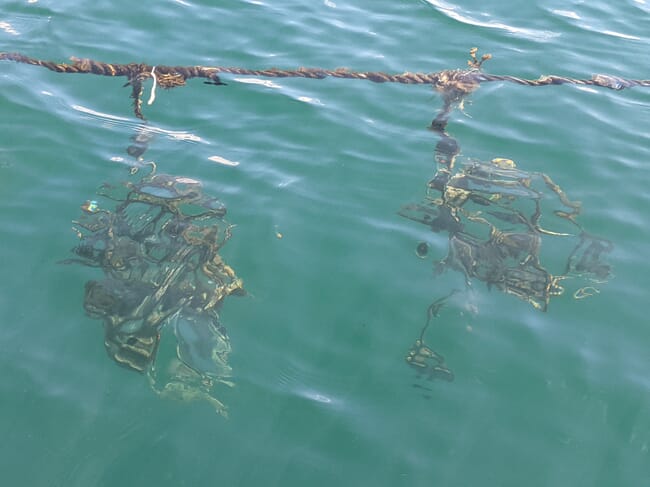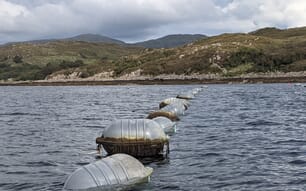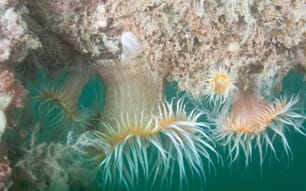
Spat collection is one of the key time periods in any mussel farmer’s diary. Spat is the term given to very young shellfish, which in their larval form float around in the surface layers of water until they come into contact with a suitable substrate to which they then attach themselves, using hair like structures called byssal threads.
In an ideal world you’d take plankton samples, and deploy your spat collection ropes when and where you’d found D-shaped mussel larvae. But, as the microscope is still on the wish list, this year we opted for deploy when the other mussel farmers do and hope for the best.
Given that the time from spat collection to harvest is 30 to 36 months (the same time period before any income is generated) it’s critical to get those ropes in the water in time for the young mussels to attach themselves. Sounds simple enough, but it actually involves many jobs.
The word is that every mussel site has a different depth and time window which is best for spat collection. Environmental conditions – including water salinity and current – dictate the best depth for setting your spat collection ropes at (anything from the top 1m to 4m deep), and timing depends on location. Different mussel farmers use different types and systems of rope for their spat collection, so we decided to try a few different methods at our sites to work out what is most productive for us and our site conditions.
Preparing the header lines
The first step in getting the site ready is to prepare the header lines. Making use of the old lines at the site saved us money, but not time and effort. Cleaning the lines took an age, as we had to remove all the old remnants of rope that had once held a mussel float or a dropper line. The header ropes last many, many years but can fray due to friction in very stormy conditions if anything tied on isn’t fixed firmly enough, so we needed to remove any that weren’t intact, to be spliced and reused at a later date.
The next step was to tie on the floats, and that in itself is not simple. We tried one technique we’d seen online but knew that if you don’t tie them on firmly enough they’ll rub and cut through the header lines. So we later went back and lashed them all on again with a thinner rope, which seemed much more secure.
A lovely Irish mussel farmer emailed us out of the blue and detailed the hydraulic system they use for tying on floats – it looks amazing, effective and simple to use, so is now also on the wish list. Most of our lines are double header lines – ie two 32 mm diameter lines, which are 220 m long and held apart by 400-litre floats. However, we also decided to trial a single header rope attached only at one end to a float. We made this header line up ashore, attaching the floats every 20 m and coiling the rope. Our voe boat did us proud – even with her little 25hp engine. Towing out the line and floats to the site and uncoiling them seemed way easier than we’d expected. Right until the engine died mid-way through uncoiling, just as the wind picked up. Much head scratching later, engine fixed and a new fuel primer bulb ordered, and the line was in and tied safely to the moorings.
We were also told by several of our mussel farmer friends to ensure that the header ropes are tight. This involves choosing the calmest day you can, at low water. Once at the connection point between the two header ropes and the mooring line, put tension in the ropes and pull as tight as possible – we used a chain block and a lot of oomph to pull out the slack before retying the header lines to mooring lines. It was amazingly satisfying to see the double header line with 400-litre floats pull into a straight line between the moorings at each end. And, more importantly, this should then reduce any chance of lines tangling and means there is space between the header lines for manoeuvring the mussel boats without snagging a propeller.

Preparing the spat collection ropes
The next stage is to prepare the spat collection ropes. We decided to trial two different spat collection methods at our sites in Loch Slapin and Loch Eishort. This would allow us to compare levels of production and ease of deployment and eventually harvesting of the two different systems – plus it made sense to reuse the droppers that we had salvaged from the seabed rather than buy new.
Dropper lines are generally 6-8 m of polypropylene rope, with a weight at the bottom. At 20 cm intervals there are plastic pegs through the rope that help support the mussels as they grow and stop them sliding off the rope. The droppers are coiled so they hang in the top couple of metres of water, as this is best for spat collection, while the slightly lower salinity in the surface waters reduces the biofouling on the ropes.
The droppers are tied onto the header ropes with a clove hitch, and we set up a system with the header ropes over the bow of the boat, tied on the droppers and then pulled ourselves along to the next section of headers.
Yes, it would be easier with a crane… and, yes, that too is on the wish list! Once the mussels have settled and have grown a little – generally by late July / early August – the coils are undone and released to their full length, giving the mussels space to grow. We have been advised not to leave it too long to untie the coils, or the mussels at the centre of the coil can move to the outer part, leaving lots of bare rope. The mussels can also put out a lot of beard, causing the coils to form a mass and making it difficult to uncoil, as well as reducing productivity.
The continuous spat line is one long rope that is tied on in such a way that the loops hang at a depth of around 3.5 m. The special rope has a lead core so it sinks and is made of a loopy material which helps the mussels to attach readily. We bought these second-hand and we pulled all 1.4 km of spat line from the bag, laid it out along the slipway, checked it over and tied on the snood ropes at about 7 m apart (we later tied on the snoods in situ as it was actually much more efficient). We then hand pulled the rope onto the voe boat and off to deploy, again the trusty clove hitch using a snood line to attach the top of the loops of continuous to alternating header ropes.

The weather gods were with us for the whole two weeks and getting four lines deployed with the amazing assistance of a good friend was incredibly satisfying for our first year. A few days later and a storm blew through, so we headed out afterwards. Only one, out of many thousands of knots, had come undone. And the water was crystal clear, so we could see how well the ropes were sitting in the water... and relax.
Well, not really: there are still a lot of old ropes to salvage from the site and get ready for next year – the plan is to not be cleaning header ropes in February but instead to make the most of the summer weather so we will be more than ready for next year’s spat. And now it’s a waiting game and our fate is in the hands of nature. We’re excited and nervous about the prospect of checking the lines in a few months’ time to see what's there.
As ever a massive thanks to our fellow mussel farmers, your guidance and friendships have helped us invaluably. And to Graeme, thanks so much for everything you have done – we couldn’t have got this far without you.
Follow us on Instagram or Facebook – @isleofskyemusselcompany for regular progress updates






